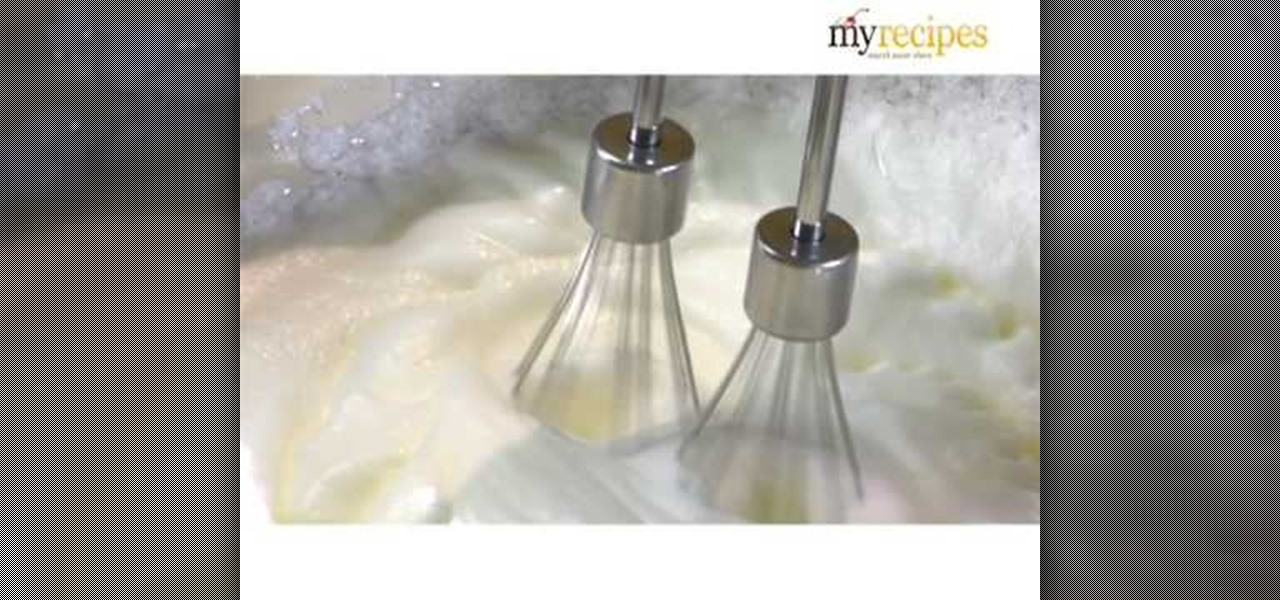
How To: Create lush, beautiful curls
Shirley Temple curls aren't the only way you can curl your hair. Forget those iron-fisted curls of your childhood and make your hair curly and beautiful the adult way by watching this video.


Shirley Temple curls aren't the only way you can curl your hair. Forget those iron-fisted curls of your childhood and make your hair curly and beautiful the adult way by watching this video.

Sure, carbon and oxygen are two of very most fundamental building blocks of all life on Earth — but what have they done for you lately? With this free video guide, you'll learn how to build a safe, simple carbon-dioxide-powered bottle rocket with baking soda and a spent soft plastic waterball.

This demonstrates the difference between hard polymers and soft polymers. The bag does not leak water as it molds to the softer polymer of the bag. If the pen had poked a harder polymer, most likely, there would have been leaking from the holes. This demonstrates characteristics of water, and how polymers can work. This also shows how certain leaks can be stopped.

Here's how to get egg whites like a pro. Quit worrying about getting egg shell specks in your whites. This is a tutorial specific to beating the eggs. Don't over beat your eggs. You want to go from foamy to soft peaks to stiff peaks.

Watch this instructional video to make cheap molds for casting miniatures. You can then duplicate pieces for building your diorama or game terrain. Sculpt original forms using polymer clay, and layer on latex to make a cheap rubber mold. Or, you can use pre-made forms to press shapes into a soft mold. This video provides several modes of creating plaster forms and duplicates for miniature sculptures.

Like the crab that symbolizes them, Cancers can be a little soft-shelled at times, so woo these sensitive souls cautiously. Learn how to use astrology advice in dating, by watching this how-to dating video. Pick up tips on making a relationship with a Cancer work. Here a hint, do something nice for a Cancer when you suggest an activity for the both of you to do.

The hot, crisp skinned salmon tops a warm, soft, earthy mushroom and potato salad; both are surrounded by a cool, tangy tomato citronette (vinaigrette made with citrus instead of vinegar). You'll be amazed how delicious the skin of the salmon gets when cooked this crisp!

Here I use lampworking to make the classic plunge dot bead. I use COE 104 soft-glass - dark purple, light purple, periwinkle and clear. Under 10 minutes with seconds to spare... Whew.. Enjoy!

Not just for your skin anymore! This tutorial, perfect especially for women of African descent, shows you an all-natural way to soften your hair. You will need: 1 cup Aztec brand Bentonite clay, 4 tablespoons of apple cider vinegar, 1/2 cup distilled water and a mixing bowl.

This tutorial works best with soft fabrics, like jersey or terry cloth. You can even cut up old flannel to make the stuffing! This is a simple project that won't take longer than an hour or two to put together.

Most seeds have a thick outer shell meant to protect the soft inner seed. 'Nicking' is a gardening technique to remove the outer shell so the seed will germinate faster in your garden after planting. You can use water, sandpaper, a nail file or even sulfuric acid to nick your seeds.

Cheap, giant croutons can make for painful eating. No one wants to interrupt a soft, fluffy salad with a giant, hard to chew chunk of stale bread. In this clip from CHOW, learn how to make perfect, bite sized mini-croutons that everyone will enjoy and add the exact right crunch to your veggies.

If you have kids, chances are you also have a pile of t-shirts that said rapidly-growing little ones have outgrown. Rather than throw them out or donate them, make them into something new! This video from Threadbanger will teach you how to sew two old t-shirts into a fun new tote bag. It will be soft, durable, stylish, and free!

-Fold paper where you want it cut -Take a wet piece of string and insert it in the fold, pressing it firmly

This video shows you how to make a simple, DIY ring light for your point and shoot Canon G10 or G11 camera. By using either cool white or warm white LED lights, you can set your white balance presets to daylight or tungsten. Ring lights are incredibly useful in fashion photography for an even, soft light with a striking eye light.

John Jacobs' Golf Schools present Quick Tips: Pitching. Director of Instruction Tom Perkins explains how to get over an obstacle when close to the green. Pitching is a shot where you spend a lot of time in the air. It helps you to get over an obstacle. It should sit soft and not roll very much.

This Photoshop software tutorial demonstrates how to combine the refined edges of the Pen Tool and the soft transparent qualities of the Extract Tool to create monster masking effects. The results are well worth the effort. Learn how to use advanced masking techniques to make cool smoke effects coming from a monster in Photoshop.

This is a lampworking demo of how to make a bead that has a tie-dyed look. Ross used soft-glass for this bead.

For a hearty, healthy, vegetarian alternative to a hamburger, try a grilled portobella mushroom burger. Made with portabella mushrooms, garlic, arugala, red and yellow roasted peppers, goat cheese on a soft roll.

Experts tell us that in order to maintain healthy hair we must avoid blowdrying it as much as possible. But let's be honest with each other here, ladies: The blowdryer is our best friend. Without it, we'd be either staying up until 1 AM at night waiting for our darned locks to dry or waking up at 5 AM so everything dries and sets before we head off to work.

Maria shows how she keeps her family's tummies full by making a hearty and filling Winter Minestrone. Minestrone is an Italian based soup made up of many different vegetables. This particular soup has onions, celery, carrots and garlic. You start by heating up oil in your pot. Then you add in your vegetables and let them get soft. Season your food by sprinkling on some black pepper, salt and rosemary. The great thing about making minestrone soup you can add whatever vegetables that you have o...

In this two-pat installment from his video tutorial series (in which he covers everything from improving timekeeping to creativity and orchestrations in patterns and drum fills), Brian Ferguson discusses the hi-hats and takes a comparative look at the most common techniques for playing them.

In this installment from his video tutorial series (in which he covers everything from improving timekeeping to creativity and orchestrations in patterns and drum fills), Brian Ferguson offers his advice for taking paradiddle variations just a little bit further than you might have thought possible.

Watch skilled potter, Simon Leach, give his expert instructions on how to glaze a set of tea bowls. He also suggests some household supplies which can be used to embellish your ceramics when the clay is still soft, such as a bolt or a comb. This glaze is a combination of Scotland Hills red mud, feldspar and wood ash. He also uses white clay slip on some of the pots. This is a process wear one glazes the tea bowls while the clay is still semi-soft.

Learn how to do the prop spin using a mace with this tutorial. This is a very basic move for drum majors and baton twirlers. Watch this how to video and you will be able to a prop spin with a mace.

Learn how to do the side flourish using a mace with this tutorial. This is a basic move for drum majors and baton twirlers. Watch this how to video and you will be able to do a side flourish with a mace.

Learn how to do the rifle toss using a mace with this tutorial. This is a basic move for a drum major or a baton twirler. Watch this how to video and you will be able to do the rifle toss with a mace.

Learn how to perform the basic toss using a mace with this tutorial. This is a beginning move for drum majors and baton twirlers. Watch this how to video and you will be able to do the basic toss with a mace.

Learn how the do the two handed neck wrap using a mace with this tutorial. This is an intermediate move for drum majors and baton twirlers. Watch this how to video and you will be able to do a two handed neck wrap with a mace.

Learn how to do the behind the back move using a mace with this tutorial. This is an intermediate move for drum majors and baton twirlers. Watch this how to video and you will be able to perform the behind the back move with a mace.

Learn how to do the behind the back pass using a mace with this tutorial. This is an easy way to transfer the mace from one hand to the other. This is an advanced move for drum majors and baton twirlers. Watch this how to video and you will be able to do the behind the back pass with a mace.

Learn how to do the one handed neck wrap using a mace with this tutorial. This is an advanced move for a drum major or baton twirler. Watch this how to video and you will be able to do the one handed neck wrap with a mace.

Learn to do the thumb roll using a mace with this how to video. This is an advanced technique for drum majors or baton twirlers. Watch this tutorial and you can do the thumb roll with a mace.

Learn how to do the palm spin using a mace with this how to video. This is an advanced move for a drum major or baton twirler. Watch this how to video and you will learn how to do palm spin with a mace.

In this lesson, you will learn four unique sixteenth note accent fills. These are slightly more advanced than the sixteenth note fills from a previous lesson, and are perfect for use within rock and related styles.

This lesson covers six unique sixteenth note accent beats. These are ideal for intermediate to advanced drummers that are looking for new ways to spice up their grooves. The patterns are somewhat similar to the two-handed sixteenth note beats, but they incorporate accents on certain hi-hat strokes.

Are you a beginner or intermediate drummer that would like to learn how to count various time signatures, note values, and sub-divisions? If the answer to either of those questions is yes, you've come to the right place. The video lessons in this section will teach you all the essentials in step-by-step detail!

Check out this instructional video on how to build heavy duty leaders for bull red, black drum, and shark.

In percussion, the paradiddle is a four-note pattern of the form RLRR or LRLL. When multiple paradiddles are played in succession, the first note always alternates between right and left. Paradiddles. Isn't that a funny word? It's reason enough to watch this.

Learn how to close the hi-hat while playing the cowbell pedal with your heel. Alan Schechner will show you how to do it. Or you can just find a cow with a bell on it, and hit it. But this will probably be better.